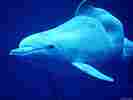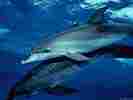
dolphins
Wild Animals
alligators
baboons
bears
chimpanzees
crocodiles
deer
dolphins
elephants
foxes
giraffes
gorillas
leopards
lions
seals
sharks
snakes
tigers
whales
wolves
zebras
Pets
dogs
cats
fish
birds
|
This site provides you with the information about dolphins, dolphin information online, dolphin pictures online, dolphin photos, dolphin pics for kids, images of dolphins, dolphin description, free dolphin info, and more.
If you think that this site is helpful, please recommend your friends to visit our site.
dolphins
I INTRODUCTION
Dolphin, aquatic mammal closely related to whales and porpoises. Sleek and powerful swimmers found in all seas, dolphins are distinguished from porpoises by well-defined, beaklike snouts and conical teeth. The porpoise has a blunt snout, chisel-shaped teeth, and a stouter body.
There are at least 32 species of dolphins. Typical examples are the bottle-nosed dolphin, a popular performer in seaquariums, and the common dolphin, which inspired many Mediterranean folk legends. Both often appear in open waters, making their characteristic arched bounds, frequently before the bow waves of ships. Several freshwater species inhabit river estuaries in Asia and South America. The small, graceful tucuxi dolphin, also known as the buffeo, or river dolphin, has been sighted more than 2000 km (more than 1250 mi) up the Amazon River. The tucuxi, the smallest dolphin, is less than 1.2 m (less than 4 ft) long; the largest, the bottle-nosed dolphin, reaches a length of 3 m (10 ft). The killer whale is considered a dolphin despite its much greater length of 9 m (30 ft). The pilot whale is also considered a type of dolphin.
Dolphins once were hunted commercially, especially for the small quantity of valuable oil extracted from parts of the head and used to lubricate delicate watch mechanisms. Cheaper oils have now been found from other sources, and dolphins are no longer hunted for this reason. Many dolphins, however, become accidentally trapped and drowned in tuna nets; between 1959 and 1972 an estimated 4.8 million dolphins died in this way. Under pressure from animal rights activists and United States consumers, both domestic and international tuna canners have refused to accept shipments from fishing fleets that do not protect dolphins. Concern has also been expressed about the treatment of dolphins on display in public aquariums and in "swim with the dolphins" programs. The Marine Mammal Protection Act of 1972, amended in 1988 and 1992, was passed to prevent exploitation of dolphins and related aquatic animals. The National Marine Fisheries Service is the principal regulatory agency.
II BEHAVIOR
In one day dolphins eat an amount of food, mostly fish and squid, equal to nearly one-third of their weight. Dolphins are swift enough to easily outdistance their prey. They seize their catches with jaws that have from 200 to 250 sharp teeth. Dolphins follow schools of fish in groups of varying size. Some species, such as the Pacific white-sided dolphin, make up aggregations estimated at tens of thousands of members. Less gregarious species, such as the bottle-nosed dolphin, join in groups that often contain only a few members.
Dolphins, like whales, breathe through a blowhole at the top of the head. As they travel they break surface about every two minutes to make a short, explosive exhalation, followed by a longer inhalation before submerging again. The tail, like that of other aquatic mammals, strokes in an up-and-down motion, with the double flukes driving the animal forward; the flippers are used for stabilization. Dolphins are superbly streamlined and can sustain speeds of up to 30 km/h (up to 19 mph), with bursts of more than 40 km/h (more than 25 mph). Their lungs, which are adapted to resist the physical problems created for many animals by rapid changes in pressure, enable them to dive to depths of more than 300 m (more than 1000 ft).
Adults of the bottle-nosed dolphin-the best-studied species-come to sexual maturity after 5 to 12 years in females and 9 to 13 years in males. They mate in the spring; after a gestation period of 11 or 12 months, a single calf is born, tail first. Calves swim and breathe minutes after birth; they nurse for up to 18 months. They are able to keep up with the mother by remaining close and taking advantage of the aerodynamic effects of the mother's swimming.
III VOCALIZATIONS AND INTELLIGENCE
Dolphins almost constantly emit either clicking sounds or whistles. The clicks are short pulses of about 300 sounds per second, emitted from a mechanism located just below the blowhole. These clicks are used for the echolocation of objects and are resonated forward by the so-called oily melon, which is located above the forehead and acts as an acoustic lens. Echoes received at the area of the rear of the lower jaw are transmitted by a fat organ in the lower jaw to the middle ear. This echolocation system, similar to that of a bat, enables the dolphin to navigate among its companions and larger objects and to detect fish, squid, and even small shrimp. The whistles are single-toned squeals that come from deeper in the larynx. They are used to communicate alarm, sexual excitement, and perhaps other emotional states.
Because of the ability of dolphins to learn and perform complex tasks in captivity, their continuous communications with one another, and their ability, through training, to approximate the sounds of a few human words, some investigators have suggested that the animals might be capable of learning a true language and communicating with humans. Most authorities, however, agree that although the dolphin's problem-solving abilities put the animal on an intelligence level close to that of primates, no evidence exists that dolphin communications approach the complexity of a true language.
The name dolphin is also applied to food fish of a different genus that have long, continuous dorsal fins. The fish, found worldwide in tropical marine waters, can reach a length of 1.5 m (5 ft).
Scientific classification: Dolphins belong to the suborder Odontoceti of the order Cetacea. The bottle-nosed dolphin is classified as Tursiops truncatus, the common dolphin as Delphinus delphis, and the tucuxi dolphin as Sotalia fluviatilis. The killer whale is classified as Orcinus orca. Pilot whales make up the genus Globicephala. The white-sided dolphin is classified as Lagenorhynchus obliquidens.




|